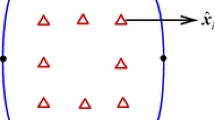Abstract
The accuracy of the dual reciprocity boundary element method for two-dimensional elastodynamic interior problems is investigated. A general analytical method is described for the closed form determination of the displacement and traction tensor corresponding to radial basis functions and explicit expressions of these tensors are provided for a number of specific basis functions. For all these basis functions the accuracy of the dual reciprocity boundary element method is numerically assessed for three interior plane stress elastodynamic problems. The influence of internal points on the accuracy of the solution is also considered. Useful results concerning the suitability of the various basis functions for solving plane elastodynamic problems are obtained.
Similar content being viewed by others
References
Abramowitz M.; Stegun I. A. 1970: Handbook of Mathematical Functions, Dover Publications, New York.
Ahmad S.; Banerjee P. K. 1986: Free vibration analysis by BEM using particular integrals, Journal of Engineering Mechanics of the ASCE 112: 682–695
Alessandri C.; Tralli A. 1991: The use of spline approximated particular integrals in the free vibration analysis of membranes by BEM, in Boundary Integral Method: Theory and applications, L.Morino and R.Piva, Eds. Springer-Verlag, Berlin, 35–44
Brand L. 1966: Vector and Tensor Analysis, J. Wiley, London
Chen Y. M. 1975: Numerical computation of dynamic stress intensity factor by Lagrangian finite differences method, Engineering Fracture Mechanics 7: 653–660
Cheng A. H.-D.; LafeO.; GrilliS. 1994: Dual reciprocity BEM based on global interpolation functions, Engineering Analysis with Boundary Elements 13: 303–311
Chirino F.; Gallego R.; Saez A.; Dominguez J. 1994: A comparative study of three boundary element approaches to transient dynamic crack problems, Engineering Analysis with Boundary Elements 13: 11–19
Coleman C. J.; Tullock D. L.; Phan-Thien N. 1991: An effective boundary element method for inhomogenous partial differential equations, Journal of Applied Mathematics and Physics (ZAMP) 42: 730–745
Dominguez J. 1993: Boundary Elements in Dynamics, Computational Mechanics Publications, Southampton and Elsevier Applied Science, London
Fedelinsky P.; Aliabadi M. H.; Rooke D. P. 1994: The dual boundary element method: J-integral for dynamic stress intensity factors, International Journal of Fracture 65: 369–381
Golberg M. A. 1995: The numerical evaluation of particular solutions in the BEM — A review, Boundary Elements Communications 6, 99–106
Golberg M. A.; Chen C. S. 1994: The theory of radial basis functions applied to the BEM for inhomogeneous partial differential equations, Boundary Elements Communications 5: 57–61
Grundemann H. 1989: A general procedure transferring domain integrals onto boundary integrals in BEM, Engineering Analysis with Boundary Elements 6: 214–222
Huang Q.; CruseT. A. 1993: Some remarks on particular solution used in BEM formulation, Computational Mechanics 13: 68–73
Kontoni D. P. N.; Beskos D. E. 1993: Transient dynamic elastoplastic analysis by the dual reciprocity BEM, Engineering Analysis with Boundary Elements 12: 1–16
Loeffler C. F.; MansurW. J. 1987: Analysis of time integration schemes for boundary element applications to transient wave propagation problems, in Boundary Element Techniques: Applications in Stress Analysis and Heat Transfer, C. A.Brebbia and W. S.Venturini, Eds, Computational Mechanics Publications, Southampton, 105–122
Manolis G. D.; BeskosD. E. 1988: Boundary Element Methods in Elastodynamics, Unwin-Hyman, London
Nardini D.; Brebbia C. A. 1982: A New approach to free vibration analysis using boundary elements, in Boundary Element Methods in Engineering, C. A.Brebbia, Ed., Springer-Verlag, Berlin, 313–326
Nardini D.; Brebbia C. A. 1983: Transient dynamic analysis by the boundary element method, in Boundary Elements, C. A.Brebbia, T.Futagami and M.Tanaka, Eds, Springer-Verlag, Berlin, 719–730
Nardini D.; Brebbia C. A. 1985: Boundary integral formulation of mass matrices for dynamic analysis, in Topics in Boundary Element Research Vol. 2: Time-Dependent and Vibration Problems, C. A.Brebbia, Ed., Springer-Verlag, Berlin, 191–208
Partridge P. W.; Brebbia C. A.; Wrobel L. C. 1992: The Dual Reciprocity Boundary Element Method, Elsevier Applied Science, London
Polyzos D.; Dassios G.; Beskos D. E. 1994: On the equivalence of dual reciprocity and particular integrals approaches in the BEM, Boundary Elements Communications 5: 285–288
Powell M. J. D. 1990: The theory of radial basis function approximation, Internal Report, Dept. Math. Theor. Phys., University of Cambridge, U.K.
Rekach V. G. 1979: Manual of the theory of elasticity, Mir Publishers, Moscow
Tang W.; Brebbia C. A. 1989: Critical comparison between two integration methods for taking BEM domain integrals to the boundary, Engineering Analysis with Boundary Elements 6: 185–191
Tang W.; Brebbia C. A.; Telles J. C. F. 1987: A generalized approach to transfer the domain integrals onto boundary ones for potential problems, in Boundary Elements IX, C. A.Brebbia, W. L.Wendland and G.Kuhn, Eds, Springer-Verlag, Berlin, 99–116
Yamada T.; Wrobel L. C. 1993: Properties of the Gaussian radial basis functions in the dual reciprocity boundary element method, Journal of Applied Mathematics and Physics (ZAMP) 44, 1054–1067
Yamada T.; Wrobel L. C.; Powel H. 1994: On the convergence of the dual reciprocity boundary element method, Engineering Analysis with Boundary Elements 13: 291–298
Zheng R.; Coleman C. J.; Phan-Thien N. 1991: A boundary element approach for non-homogeneous potential problems, Computational Mechanics 7: 279–288
Author information
Authors and Affiliations
Additional information
Communicated by T. Cruse, 29 September 1995
Rights and permissions
About this article
Cite this article
Agnantiaris, J.P., Polyzos, D. & Beskos, D.E. Some studies on dual reciprocity BEM for elastodynamic analysis. Computational Mechanics 17, 270–277 (1996). https://doi.org/10.1007/BF00364830
Issue Date:
DOI: https://doi.org/10.1007/BF00364830




